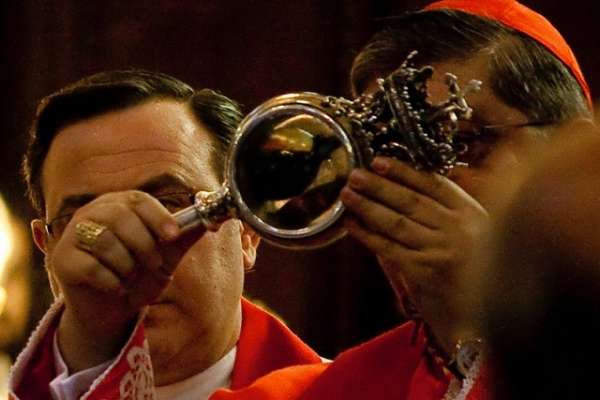The blood of San Gennaro liquefies in Naples

The blood of the first martyr of the San Gennaro Church liquefied in Naples on Saturday, repeating a miracle dating back to at least the fourteenth century.
The blood was declared to have passed from solid to liquid at 10:02 in the Cathedral of the Assumption of Mary on 19 September, the feast of San Gennaro.
Cardinal Crescenzio Sepe, archbishop of Naples, announced the news to a mostly empty cathedral, due to coronavirus restrictions.
“Dear friends, dear all the faithful, once again with joy and emotion I inform you that the blood of our holy martyr and patron San Gennaro has liquefied,” said Sepe.
His words were greeted by applause from those present inside and outside the cathedral.
Sepe added that the blood had "completely liquefied, without clots, which has happened in past years."
The miracle is "a sign of the love, goodness and mercy of God, and of the closeness, friendship, fraternity of our San Gennaro", said the cardinal, adding "Glory to God and veneration to our saint. Amen."
San Gennaro, or San Gennaro in Italian, is the patron saint of Naples. He was bishop of the city in the XNUMXrd century and his bones and blood are kept in the cathedral as relics. It is believed that he was martyred during the Christian persecution of Emperor Diocletian.
The liquefaction of the blood of San Gennaro takes place at least three times a year: the feast of the saint on 19 September, the Saturday before the first Sunday in May and on 16 December, which is the anniversary of the eruption of Vesuvius in 1631.
The alleged miracle has not been officially recognized by the Church, but it is known and accepted locally and is considered a good sign for the city of Naples and its Campania region.
Conversely, failure to liquefy blood is believed to signal war, famine, disease, or other disaster.
When the miracle occurs, the dried, red-colored mass of blood on one side of the reliquary becomes a liquid that covers almost the entire glass.
The last time the blood didn't liquefy was in December 2016.
The miracle occurred while Naples was blocked for the coronavirus pandemic on May 2. Cardinal Sepe offered the mass via live streaming and blessed the city with the relic of liquefied blood.
"Even in this period of coronavirus, the Lord by the intercession of San Gennaro liquefied the blood!" Sepe stated.
This could be the last time Sepe offers the feast day mass and confirms the miracle of San Gennaro. Pope Francis is expected to soon appoint a successor to Sepe, who is 77, in what is considered a very important archdiocese for Italy.
Cardinal Sepe has been archbishop of Naples since July 2006.
In his homily at mass on 19 September, the archbishop condemned the "virus" of violence and those who take advantage of others by lending money or stealing funds intended for economic recovery in the aftermath of the pandemic.
"I am thinking of violence, a virus that continues to be practiced lightly and cruelly, whose roots go beyond the accumulation of social evils that favor its explosion," he said.
“I think of the danger of interference and pollution of the common and organized crime, which seeks to grab resources for economic recovery, but also seeks to hire proselytes through criminal assignments or loans of money,” he continued.
The cardinal said he also thinks about "the evil sown by those who continue to hunt for wealth through illegal actions, profits, corruption, scams" and is concerned about the tragic consequences for those who are unemployed or underemployed and are now in an even more precarious condition. situation.
"After the blockade we are realizing that nothing is the same as before," he said, and encouraged the community to be sober in considering the threats, not just illness, to daily life in Naples.
Sepe also spoke about young people and the hope they can give, lamenting the discouragement that young people face when they can't find work.
"We all know that [young people] are the real, great resource of Naples and the South, of our communities and our territories that need, like bread, the freshness of their ideas, their enthusiasm, their skill, of their optimism, of their smile “, he encouraged